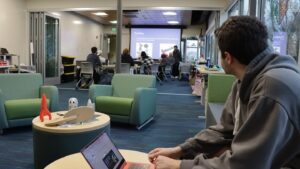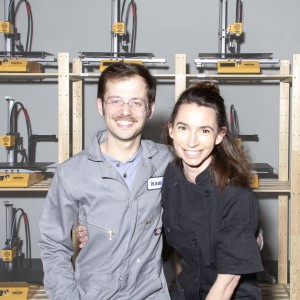The Engine Behind Creativity

What if you could “hear” color? What if you could blend the speed and functionality of quantum computing with the beauty and lyricism of poetry? What if your 3D printer could create an intricately designed, and equally delicious, dessert for you to enjoy?
 These are only a few examples of the types of questions that Stephanie and Isaac Budmen encourage through their work at Le Moyne’s Keenan Center for Entrepreneurship, Innovation and Creativity. Isaac serves as the Center’s designer of educational programming and mentorship, while Stephanie serves as designer of education content and programming. As they launch the Center’s project-based learning initiative, the Budmens work with students, faculty and the Greater Syracuse community to instill a philosophy of creative discovery. This process, they stress, begins by nurturing something that we all innately have: curiosity.
These are only a few examples of the types of questions that Stephanie and Isaac Budmen encourage through their work at Le Moyne’s Keenan Center for Entrepreneurship, Innovation and Creativity. Isaac serves as the Center’s designer of educational programming and mentorship, while Stephanie serves as designer of education content and programming. As they launch the Center’s project-based learning initiative, the Budmens work with students, faculty and the Greater Syracuse community to instill a philosophy of creative discovery. This process, they stress, begins by nurturing something that we all innately have: curiosity.
“Everyone has curiosity, and curiosity tends to be the engine behind creativity,” says Isaac. “It’s that, ‘What if?,’ that we label as creative. Curiosity is a much easier on-ramp for everybody because everyone has questions. Everyone has something they’re curious about.”
This philosophy was on full display this spring at the second-annual Syracuse Maker Faire, which the Keenan Center hosted. The Budmens worked with a group of ERIE21 students, who built a theme park that then debuted at the Faire. The students chose the theme and designed the attractions based on their own interests and desires. This student-guided approach led to some remarkable projects, such as a tour of the solar system complete with videos introducing each planet. It also led to some deeper shifts in learning. For example, one young female student hesitantly asked Stephanie if she could build something.
“I turned to her and I said, ‘Absolutely. You can do this,’” Stephanie recalls. “Her entire body language changed, her entire demeanor changed, and in a split second, this young lady went from very shy to totally confident. By the end of the program, she was leading a whole group of young ladies.”
The transformative power of project-based learning is central to the Keenan Center’s “build it” mentality. It is also something that the Budmens live and breathe in their own lives. Today they co-manage Budmen Industries, selling custom-made 3D printers and their own “impossible projects,” and their road to this professional life is full of learning and creative discovery.
As an undergraduate, Stephanie studied photography and art history; post-college, she became a wedding photographer and moved to Chicago. On the side, she began working in restaurants and discovered a love of baking, eventually becoming the top pastry chef at a Michelin-star restaurant.
“I thought, ‘Oh wow, I can elaborate on this toolbelt I have,’” says Stephanie. “I don’t have to stay in one silo. I can explore these different avenues.”
Isaac, too, has a similar story. As a policy major in college, he started taking courses his senior year on different subjects that had always interested him, such as software and entrepreneurship. Then, after graduation, he and two of his college roommates formed an interactive design group that designed and sold a wide range of “crazy projects,” such as a gumball machine that would dispense gumballs if a person checked in to Google on their phone. After receiving a contract for a small 3D printer, Isaac became hooked, learning everything he could about the relatively new technology and eventually writing a book about 3D printing. From there, he was invited to the Metropolitan Museum of Art to be a part of the media lab team in the digital fellows program, where he continued to work extensively with 3D printing. At the same time, he and Stephanie, who had met years earlier, had reconnected. Together, they filed their first patent for a large 3D printer.
Their journeys and mindsets embody the Keenan Center’s four pillars of innovation, entrepreneurship, creativity and intrapreneurship. In other words, it is the combination of their unique business acumen and their inventive approach that makes them a natural fit for the Center. At Budmen Industries, they’ve created everything from medical equipment to 3D printed desserts to a sculpture of Neil Harbisson, the world’s first cyborg, that allows the viewer to “hear” color.
Their vision for the Keenan Center’s future is no less imaginative or ambitious. From instructing an upcoming stop motion summer camp to organizing poetry readings and open mic nights, the Budmens hope to emphasize creative exploration of intersections. What happens when you combine art and technology, for example? What about light and sound? Humanities and science?
“We want to let the community and the campus know that this is a place where you can ask those questions,” says Isaac. “Because that’s what we found. We came in a year ago when there was the grand opening, and there was this incredibly receptive group of people who are willing to put resources and time into asking questions, and they’re not expecting that there’s a definitive answer at the end of it. Having the opportunity to do that is enormous.”
“And we not only open our doors to the people on Le Moyne’s campus, but also to the community at large,” adds Stephanie. “We’re saying that here is a space where you can make and create and ask those questions. Let’s all discover together.”


